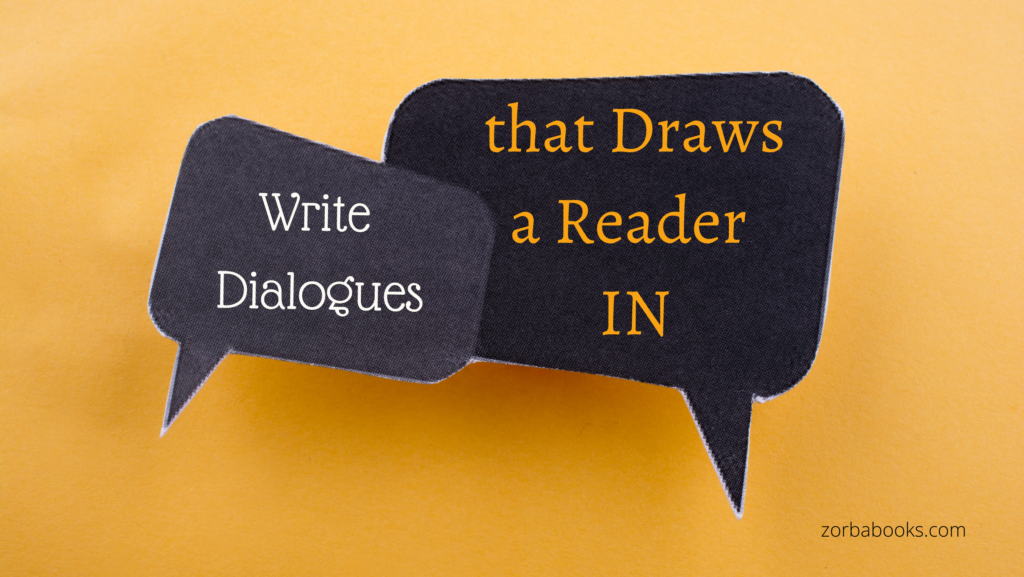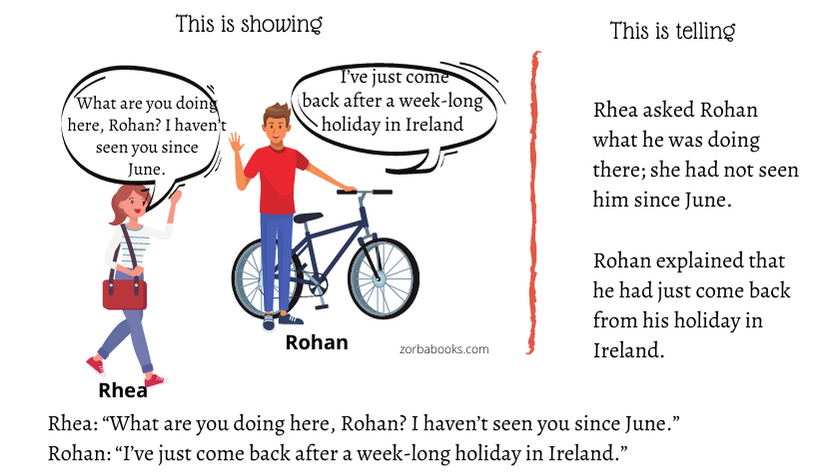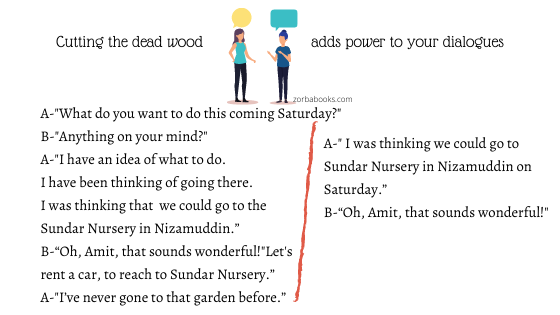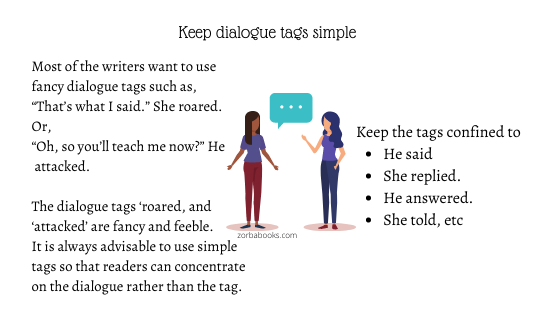
Dialogues are a must for every book because a book with conversations attracts readers. If a novel doesn’t have dialogues a reader won’t think twice before putting the book down because without conversation, it’s not even a story, it’s a mere description of situations, events and people.
The interaction between the characters of a story is essential. One starts to form a positive or negative connection, depending on the type of dialogue in a narrative. Also, showing instead of telling makes the story more engaging and exciting. You get to learn so much about the story’s characters by what and how they say things.

What are the writing dialogue rules?
For starters, as per the writing dialogue rules, the dialogues should be realistic. They shouldn’t seem artificial or made up. The best way to learn how to write such exchanges is to pay attention to your family or friends’ conversations and note the dialogues. Some of the pointers to keep in mind are:
| Writing dialogue examples: |
- Avoid greetings/small talks: You need to avoid unnecessary chatter such as greetings.
Writing dialogues example:

Excluding the initial greetings such as ‘hi’, ‘hello’ etc from this dialogue means you want to say what’s meaningful.
- Keep it simple: To keep your character believable, you need to keep the dialogues short and straightforward. A character’s exchanges need not be more than two or three sentences. Anything beyond that would seem like an explanation. Try breaking down the dialogues into parts. Cutting the deadwood adds power to the dialogues.
An example:

- Make your character’s voice unique: Another writing dialogue tip is, each one of us has a unique way of speaking. Some people are polite and humble; some are rude and outspoken. You can consider these styles for each of your characters and form their dialogues accordingly. Ensure proper word choice and pattern of speech for characterization.
- Be consistent: Once you have established a pattern of speech for each of your characters, be consistent and stick to that pattern. A shy person can’t become an extrovert suddenly. Therefore, it is essential to maintain their traits in the dialogues they deliver.
- Keep dialogue tags simple: Most of the writers want to use fancy dialogue tags such as,

- Include silence: Silence can help hold the attention of readers. Here is an example for you:
“Do you think this will work?”, said Hiresh.
“We don’t have any other option, do we?” Riya said.
The exhaust fan buzzed to life, and the tube light flickered.
“Yeah…I don’t think so,” he mumbled.
Here, we referred to the exhaust fan and the tube light to hold the reader’s interest and build suspense. It also tells us what kind of environment they both are in.
- Use proper punctuations: Using proper punctuations in the dialogues become essential to serve a knowledgeable audience is another writing dialogue tip. If you get it wrong, it looks terrible and creates a negative impression amongst the readers. Some of the tips for getting the punctuations correct are:
- Start every new dialogue for a new speaker in a new line, no matter if the dialogue is short. e.g.,
“Hey, what are you up to?” she asked.
“Nothing much,” he said.
- Commas, question marks, exclamation marks, etc., should be included inside the quotation marks. e.g., “Hey, are you there?”
- If you intend to end a dialogue with ‘he/she said’ the dialogue before this should end with a comma rather than a period. e.g., “Nope,” he said.
- Keep the usage of the type of quotation marks consistent throughout your novel. There is no set rule for what type of quotation mark (single or double) you should use. However, keeping it the same till the end is essential.
- Keep the dialogues engrossing: besides taking into account the voice, the crispness of the sentence also consider using slang here and there. Mix it up with a little banter to keep the readers glued up to your story. Give a sense of anticipation in your dialogues. Example:
“No, chill, dude.”
- Read your dialogues out loud: Try and read the dialogues you have written aloud to get a sense of how they sound. It helps you identify your problem areas and help you improve upon your work. For example, while reading a particular dialogue, if it seems unnatural or artificial, you can modify it to make it more realistic.
Avoiding these helps you create enough space for intrigue and mystery.
- Get rid of adverbs: Frequently, writers try to make the dialogues fancy by using adverbs before tags.
For example, she said happily/ he said angrily.
Rather, using these ‘ly’ adverbs just creates an unnecessary explanation and make it wordy. What is being said is more important than how it is being said. Therefore, avoid using adverbs as much as possible.
Once you have a hang of how to write engaging dialogues, you should take a look at the mistakes writers often make.
Remember, your voice is your own. You cannot learn something until you invest time and effort into it. It takes hard work and practice to make your writings enjoyable. Therefore, work hard and keep writing intriguing stories!
How to write a romantic novel revealed.
Pingback: FAQ's on Writing a Book - ZorbaBooks
Pingback: Five Secrets to an Eye-Catching Book Cover - ZorbaBooks
Pingback: Book Title Ideas: Choosing Your Own - ZorbaBooks
Pingback: Guide To Writing a Horror Story - ZorbaBooks
Pingback: Enhance Your Creative Writing Skills - ZorbaBooks